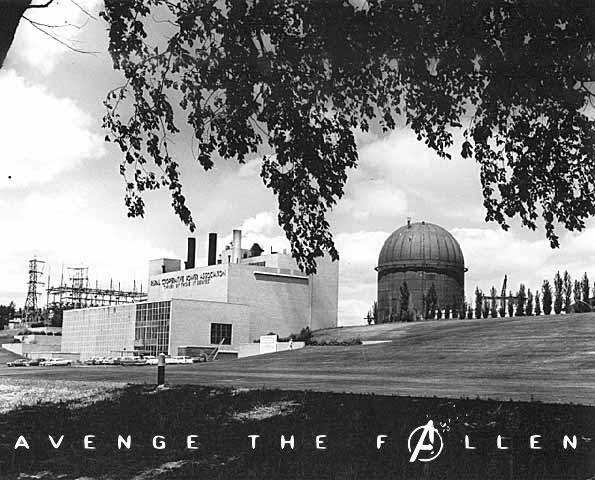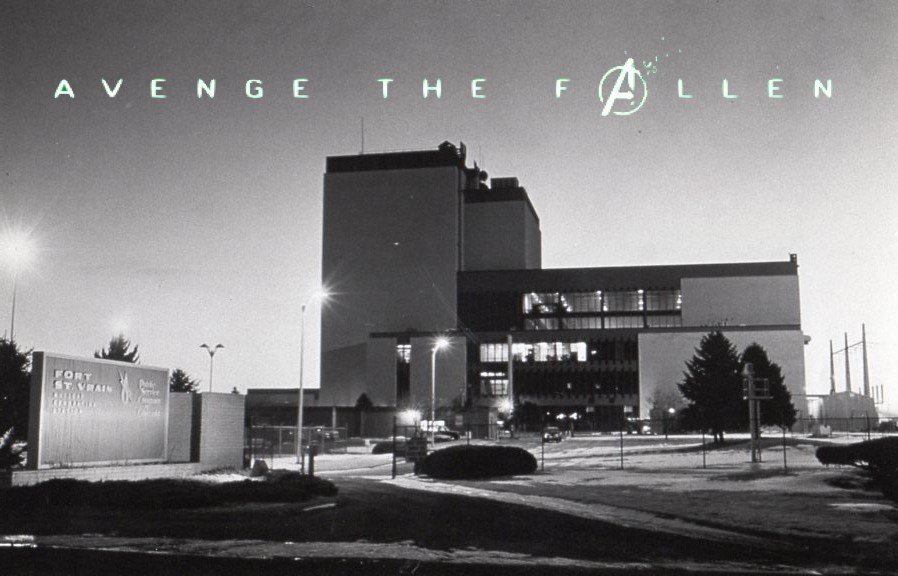
A thread of decommissioned commercial nuclear reactors in the US as Avenge the Fallen posters
#VintageNuclear
#VintageNuclear
Some quick terminology first. I'm referring to nuclear plants who have been officially designated as decommissioned or decommissioning. Once a reactor has been permanently shut down, it takes years or decades to fully dismantle it and return the land
There are multiple terms used in decommissioning a nuclear reactor.
- DECON is the status where a reactor is currently being dismantled. Some plants enter DECON shortly after shutdown, while others remain in another state (see next tweet) before entering DECON
- DECON is the status where a reactor is currently being dismantled. Some plants enter DECON shortly after shutdown, while others remain in another state (see next tweet) before entering DECON
- SAFSTOR basically means putting the reactor in a safe monitored state and waiting years or decades to let some of the radioactive materials with short half-lives decay away. This exposes workers to much less dose when dismantling but obviously takes a much longer time
Finally,
- ENTOMB is literally encasing the site in concrete. We have never done this in the US and there are no plans to do so. The famous sarcophagus surrounding Chernoby unit 4 is an example of ENTOMB
And now without further ado, The Fallen
- ENTOMB is literally encasing the site in concrete. We have never done this in the US and there are no plans to do so. The famous sarcophagus surrounding Chernoby unit 4 is an example of ENTOMB
And now without further ado, The Fallen
Elk River (MN) was a small (<60 MWt) reactor built for the Rural Cooperatlve Power Assoclatlon (RCPA). It operated from 1962 to 1968 and was dismantled and decommissioned by 1974. On the same site a coal/oil-fired plant operated until 1989 before being converted to run on refuse 

Pathfinder (SD) was a proof-of-concept reactor that superheated steam but never operated at its full power of ~200 MWt. The reactor vessel was removed 23 years after the reactor was shut down and the plant operated as an oil/gas-fired peaking plant until 2000 

Fort St. Vrain (CO) was a high-temperature gas reactor, the second to be built in the US. After the reactor was decommissioned in 1992, the facility was converted to natural gas combustion (and eventually combined-cycle). It still operates today 

Racho Seco (CA) operated from April 1975 to June 1989 and was closed by a public vote by Sacramento citizens. It had a troubled history of shutdowns, accidents, and cost overruns. The plant completed DECON 

Saxton (PA) was a small 23.5 MWt reactor. Although it produced power as a commercial plant, it was designed mainly as a research station. It was shut down in 1972 and has completed decommissioning 

Shoreham (NY) was built on Long Island and faced constant public opposition during construction. It was never given a NRC license to operate and eventually sold its unused fuel to the Philadelphia Electric Company. It has been fully decommissioned 

Yankee Rowe (MA) was the first nuclear plant in the northeast and was shut down in 1992 due to reactor pressure vessel embrittlement concerns and economic factors. Decommissioning was completed in 2007 

Trojan (OR) successfully defeated 1986, 1990, and 1992 ballot measures to close or prohibit operation of the plant. However, cracks and leaks of steam generator tubes lead to an early shutdown in 1993. The plant has completed decommissioning 

Haddam Neck/Connecticut Yankee (CT) operated for nearly 29 years but was closed due to its high operational costs. It underwent DECON, which was completed in 2007 

Maine Yankee (ME) operated from 1972 through 1996. It was the state's largest generator of electricity but like other plants in the northeast, it was shut down over lack of economic viability. DECON was completed in 2005 

Big Rock Point (MI) was the fifth commercial nuclear power plant in the U.S. I was named after a large boulder that the Odawa used as a gathering point. The plant was shut down in 1997 and has completed DECON
Vallecitos (CA) is the site of two decommissioned reactors, the Vallecitos boiling water reactor (VBWR) and less commonly known, the ESADA Vallecitos Experimental Superheat Reactor (EVESR). GE was authorized by the NRC to possess but not operate the EVESR. Both are in SAFSTOR 

The NS Savannah was the first nuclear-powered merchant ship. After being taken out of service, the Savannah was part of the Patriot’s Point Naval and Maritime Museum from 1981 to 1993 but was eventually returned to the Maritime Administration and now rests in Baltimore. 

Fermi 1 (MI) was a prototype sodium-cooled fast breeder reactor that suffered a partial core meltdown. The reactor remained shut down for four years before eventually being restarted for a short time before permanent shutdown. Unit 2, a BWR, is still operational on site 

Indian Point I (NY) was a 615 MWt PWR. The initial core load used thorium fuel. It sits in SAFSTOR as the other two units on site are still operational 

Peach Bottom 1 (PA) was the first high-temperature gas reactor in the US and operated from 19967 to 1974. While the fuel has been removed and the spent fuel pool decontaminated, most of the plant still remains in SAFSTOR. Two PWR units remain operational on site 

Humboldt Bay (CA) Unit 3 was a small natural-circulation BWR that operated from 1963 to 1967. There were two small fossil fuel plants already on site. The plant was placed in SAFSTOR but began active decommissioning in 2009 

Dresden 1 (IL) operated commercially for 18 years as the first privately financed nuclear power plant in the US. Unit 1 is in SAFSTOR while units 2 and 3 remain operational on site 

Three Mile Island Unit 2 suffered a partial core meltdown only months after it began commercial operation. It is the worst nuclear accident in the US despite releasing only a tiny amount of radiation to the environment. The plant is in SAFSTOR while unit 1 still operates 

Lacrosse (WI) was a small single-unit BWR funded as a joint effort between the Atomic Energy Commission and the Dairyland Power Cooperative. The plant is currently in DECON 

Zion (IL) was a two-unit PWR located north of Chicago on Lake Michigan. The plant shut down in 1998 and is currently undergoing DECON. Several of the buildings have been demolished in the last few years 

Millstone 1 (CT) was a BWR that permanently ceased operations in 1998. It sits in SAFSTOR while the two other units on site, both PWRs, remaining operating. I believe Unit 1 is the unit furthest to the left in the picture 

Kewaunee (WI) was a two-unit PWR that operated from 1974 to 2013. The plant shut down due to lack of economic viability. The plant is in SAFSTOR 

San Onofre 1 has been shut down since 1992. The site has been mostly decommissioned but the already-cut-up reactor pressure vessel still sits on site awaiting the decommissioning of units 2 and 3 

Crystal River 3 (FL) was a PWR that operated for 33 years until being permanently closed in 2013. The plant is part of the Crystal River Energy Complex, which also includes units 1, 2, 4, and 5, all coal-fired. The plant will be placed in SAFSTOR 

Vermont Yankee (VT) was a BWR that operated from 1972 to 2014 and accounted for about 35% of the state's electricity consumption. It closed due to economic factors and is in SAFSTOR 

Fort Calhoun (NE) was a PWR that commissioned in 1973 and was officially closed in 2016. A 2011 fire resulted in the spent fuel pools going 90 minutes without cooling and the plant stayed shuttered for 3 years. It was the smallest nuclear plant in the country at its retirement 

Oyster Creek (NJ) was a single unit BWR that shut down in September 2018, about a year before its 50th birthday. It is currently in SAFSTOR 

This thread based on these posters by @darth. I don't really want to make more of these so please support clean energy portfolio standards in your state 🙂⚛️
https://twitter.com/darth/status/1110620014330023937
• • •
Missing some Tweet in this thread? You can try to
force a refresh






